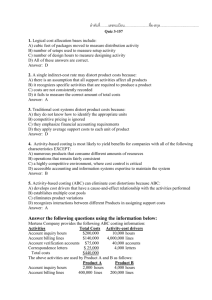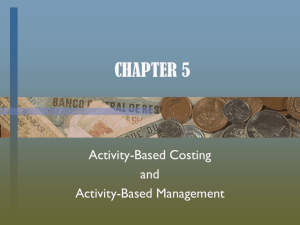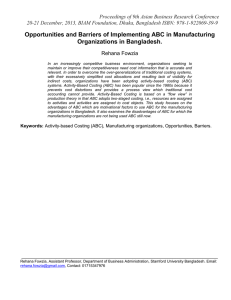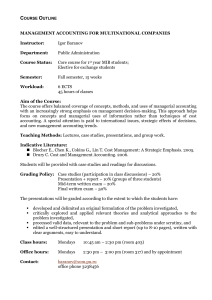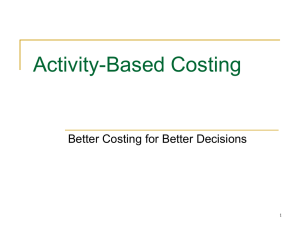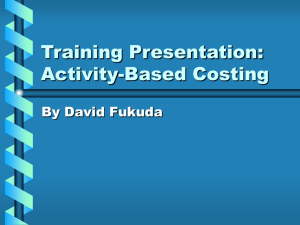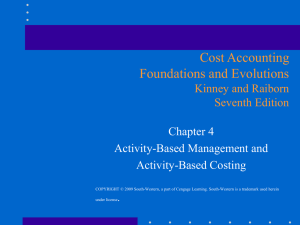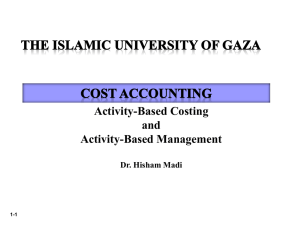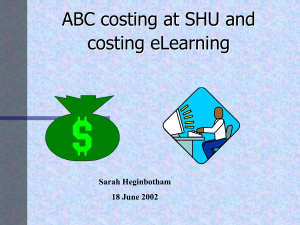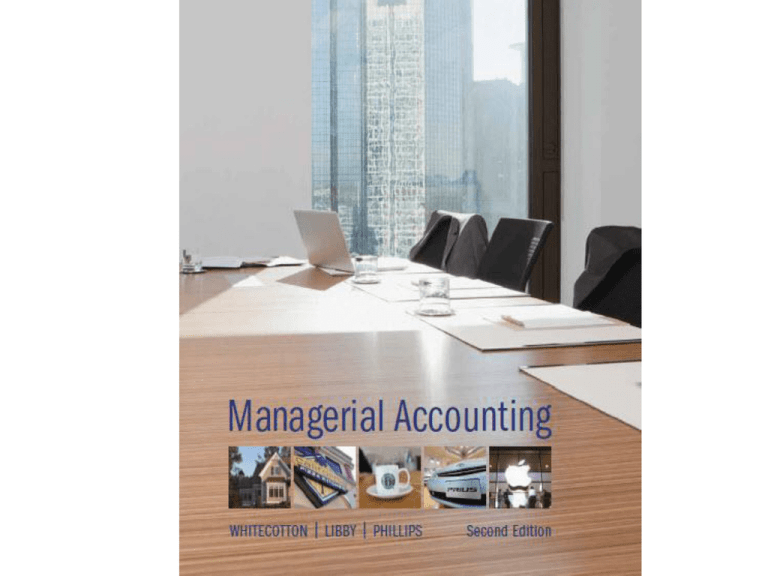
Chapter 4
Activity-Based Costing and Cost Management
PowerPoint Authors:
Susan Coomer Galbreath, Ph.D., CPA
Charles W. Caldwell, D.B.A., CMA
Jon A. Booker, Ph.D., CPA, CIA
Cynthia J. Rooney, Ph.D., CPA
McGraw-Hill/Irwin
Copyright © 2014 by The McGraw-Hill Companies, Inc. All rights reserved.
Activity-Based Costing (ABC)
Two-Stage Allocation Process Using ABC
Activity Based
Costing (ABC) is a
method of assigning
indirect costs to
products and
services based on
the activities they
require.
4- 3
Form Activity Pools and Assign Indirect
Costs to Each Pool
Assume that Toyota has grouped its
production activities into three
categories.
Machining
and
Installation
(unit level)
Machine
Setup
(batch level)
Engineering
and
Quality Control
(product level)
4- 4
Form Activity Pools and Assign Indirect
Costs to Each Pool
Recall that the total manufacturing overhead cost for the Tsutsumi plant is
estimated at $3,000,000 (in thousands) per year. 1n an ABC system, this indirect
cost must be assigned to the three activity cost pools.
4- 5
Select a Cost Driver for Each Activity Cost
Pool
Machine hours will be used as
the driver for the machining
and installation activity.
Number of set-ups will be
used as the activity driver for
the set-up activity.
Engineering and inspection
hours will be used as the
driver to assign engineering
and quality control costs.
4- 6
Activity-Rate Method
The activity-rate method is very similar to the
predetermined overhead rate computed earlier.
Total indirect costs assigned to the machining pool was $720,000.
Total machine hours required by each Toyota model is as follows:
$720,000
Activity Rate =
= $72 per machine hour
10,000
4- 7
Activity-Based Costing in Service Industries
ABC can also be useful in service industries, particularly
when different types of customers require different levels of
service. Although service providers do not have
manufacturing overhead, they incur many indirect costs,
such as rent, supplies,
supervision, advertising, and administrative expenses.
4- 8
Activity-Based Management
Activity-based management (ABM) includes all the
actions that managers take to improve operations or
reduce costs based on the ABC data. The first step in
any improvement program is to target areas that need
improvement.
What
Activities
Are
Performed?
How Much
Does it Cost
to Perform
Each
Activity?
Does the
Activity Add
Value to the
Customer?
4- 9
Just-in-Time (JIT) Inventory
In a JIT system, materials are purchased and units are
made only as they are needed to satisfy customer demand.
JIT is a "demand pull" system, where materials and
products are pulled through the manufacturing system
based on customer demand.
In a traditional manufacturing setting, products are
pushed through the system and often end up sitting in
inventory.
4- 10
Total Quality Management
Total quality management (TQM) is a management
approach that aims to improve product quality by
reducing and eliminating errors, streamlining activities,
and continuously improving production processes:
1.Prevention costs;
2.Appraisal or inspection costs;
3.Internal failure costs; and
4.External failure costs.
4- 11
Target Costing and Life Cycle Cost
Management
Target costing is a proactive approach to cost management
that managers can use to determine what costs should be
in order for the company to earn an acceptable profit
across a product’s life cycle. The product life cycle
represents the life of the product from its infancy (an idea),
through design, development, product introduction,
growth, maturity, and eventual decline.
4- 12
Target Costing and Life Cycle Cost
Management
In pursuing cost management, managers need to set their
cost reduction goals across all stages of the product life
cycle, including:
1. product introduction,
Costs tend to be higher
2. growth,
Most revenue earned
3. maturity, and
4. eventual decline.
In today’s digital and technological age,
product life cycles become increasingly short.
4- 13
Target Costing and Life Cycle Cost
Management
With target costing, the price is set by the market based
on what the company believes consumers will be willing
to pay for the product or service. The desired profit
margin is then subtracted from the market price to
determine the target cost.
The $24,000 target cost is the most that can be spent on the
product and still achieve the 20% return on sales (given a
market sales price of $30,000 per unit).
4- 14
Summary of ABC and ABM
To gain the true benefits of activity based costing,
managers must move from simply measuring costs, to find
ways to manage or reduce costs. Although ABC and ABM
have many potential benefits, these benefits must be
weighed against the costs of obtaining the more accurate
information. Implementing an ABC can be a difficult task.
4- 15
End of Chapter 4
4- 16

